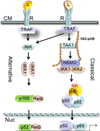NF-κB signaling and bone resorption
- PMID: 23468073
- PMCID: PMC3884829
- DOI: 10.1007/s00198-013-2313-x
NF-κB signaling and bone resorption
Abstract
The transcription factor NF-κB is a family of proteins involved in signaling pathways essential for normal cellular functions and development. Deletion of various components of this pathway resulted with abnormal skeletal development. Research in the last decade has established that NF-κB signaling mediates RANK ligand-induced osteoclastogenesis. Consistently, it was shown that inhibition of NF-κB was an effective approach to inhibit osteoclast formation and bone resorptive activity. Identification of the molecular machinery underlying NF-κB activation permitted osteoclast-specific deletion of the major components of this pathway. As a result, it was clear that deletion of members of the proximal IKK kinase complex and the distal NF-κB subunits and downstream regulators affected skeletal development. These studies provided several targets of therapeutic intervention in osteolytic diseases. NF-κB activity has been also described as the centerpiece of inflammatory responses and is considered a potent mediator of inflammatory osteolysis. Indeed, inflammatory insults exacerbate physiologic RANKL-induced NF-κB signals leading to exaggerated responses and to inflammatory osteolysis. These superimposed NF-κB activities appear to underlie several bone pathologies. This review will describe the individual roles of NF-κB molecules in bone resorption and inflammatory osteolysis.
Conflict of interest statement
Figures

References
-
- Ting AY, Endy D. Signal transduction: decoding NF-kB signaling. Science. 2002;298:1189–1190. - PubMed
-
- Baldwin AS., Jr The NF-kB and IkB proteins: new discoveries and insights. Annu Rev Immunol. 1996;14:649–683. [Review; 180 refs] - PubMed
-
- Baeuerle PA, Baltimore D. NF-kB: ten years after. Cell. 1996;87:13–20. - PubMed
-
- Hayden MS, Ghosh S. Signaling to NF-kB. Genes Dev. 2004;18:2195–2224. - PubMed
-
- Siebenlist U, Franzoso G. Structure, regulation and function of NF-kB. Proc Natl Acad Sci U S A. 2001;89:4333–4337.
Publication types
MeSH terms
Substances
Grants and funding
LinkOut - more resources
Full Text Sources
Other Literature Sources
Research Materials

